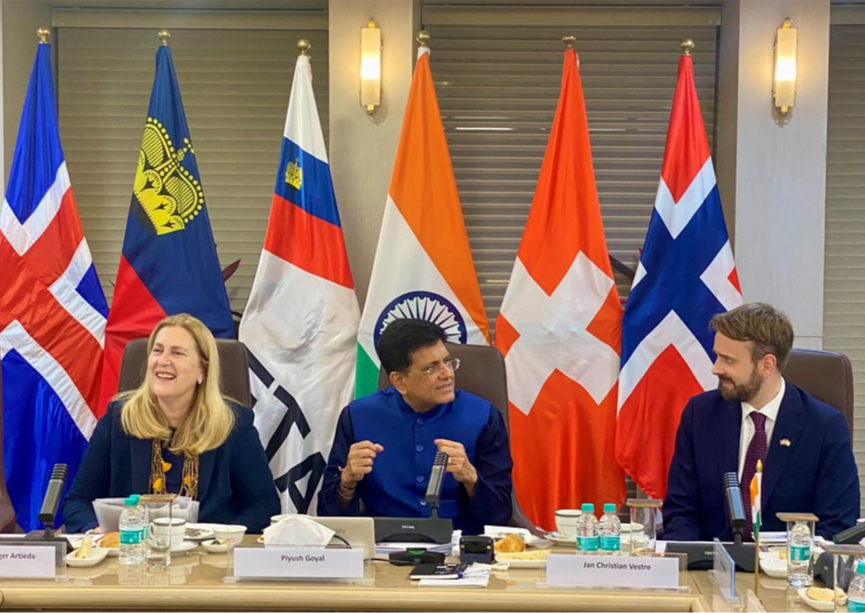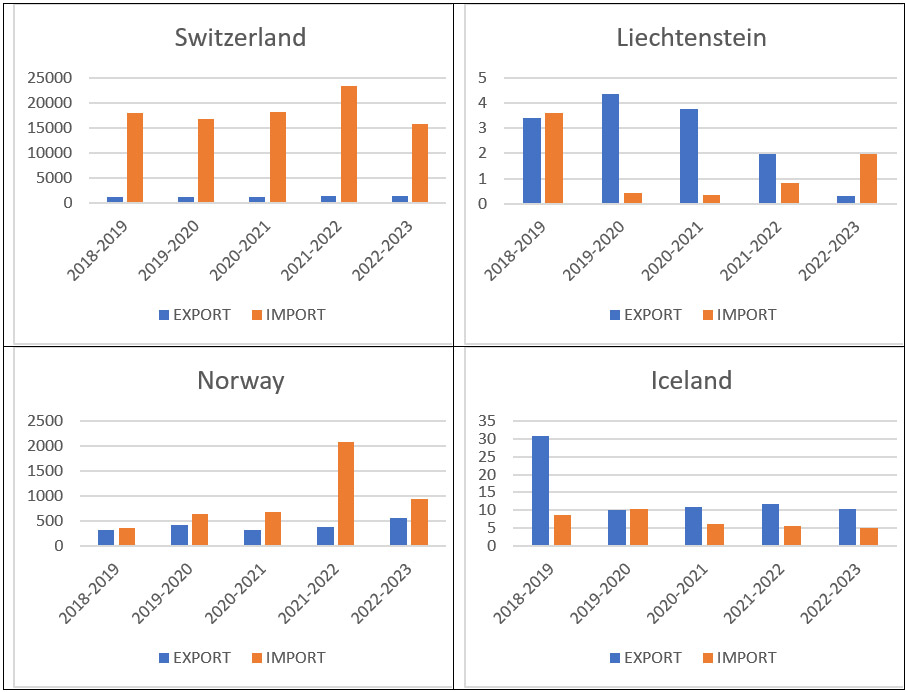-
CENTRES
Progammes & Centres
Location
India and EFTA have ratified a Trade and Economic Partnership Agreement, pledging to boost trade and investment while upholding IPR and sustainable development

India signed the Trade and Economic Partnership Agreement (TEPA) with the European Free Trade Association (EFTA), comprising Switzerland, Norway, Iceland, and Liechtenstein on 10 March 2024. Following 21 rounds of negotiations since 2008, this Free Trade Agreement was finally ratified, promising enhanced cooperation on trade, investment promotion, intellectual property, and sustainable development, among other areas. The distinctive feature of this agreement stems from the binding commitment of US$ 100 billion made by the European nations, to be invested over the next 15 years, resulting in over 1 million direct jobs. The mutual promises made in the TEPA need to be weighed, assessing what all parties stand to gain, and how India can leverage this to strengthen its trade balance.
The distinctive feature of this agreement stems from the binding commitment of US$ 100 billion made by the European nations, to be invested over the next 15 years, resulting in over 1 million direct jobs.
As of 2022-23, the EFTA countries reserve a 1.6-percent share of India’s total trade, with the total trade amounting to US$ 18.6 billion. Although Indian exports to the EFTA have increased, their share in total Indian trade in goods has been steadily declining, due to lower imports by India. This has eased India’s trade deficit with these nations. India’s top exports to the EFTA include organic chemicals, clothing accessories and electrical machinery, while it mostly imports machinery and pharmaceutical products. Thus, the decline in imports can be seen as a direct result of the import-substitution schemes which promote domestic manufacturing like the Make in India and Production Linked Incentive (PLI) Scheme.
Table 1: EFTA Nations’ Share in Indian Trade (in US$ millions)
| Year | Exports | Imports | Total Trade | Share in India's Trade |
| 2018-2019 | 1533.93 | 18466.32 | 20000.25 | 2.37 |
| 2019-2020 | 1636.1 | 17541.51 | 19177.59 | 2.43 |
| 2020-2021 | 1598.67 | 18911.17 | 20509.84 | 2.99 |
| 2021-2022 | 1742.02 | 25491.22 | 27233.24 | 2.63 |
| 2022-2023 | 1926.44 | 16738.93 | 18665.37 | 1.60 |
Source: Calculated by author from EXIM Data Bank
The TEPA has introduced multiple clauses to enhance trade among the parties, besides the regular elimination and reduction of tariffs and duties, associated with an FTA. It entails the termination of existing duties on industrial products and marine products, facilitating a more liberal trade environment among the nations. Moreover, with respect to agricultural products, India, Switzerland, and Liechtenstein have entered into agreements which will provide improved market access and heavily subsidise tariffs on both basic and processed agricultural products. In addition, the TEPA guarantees simpler, more transparent, and swift trade procedures, which will be in accord with international standards.
Figure 1: India’s Trade with the EFTA (in US$ millions)

Source: EXIM Data Bank
This guarantee is further backed by the clause which ensures reduction of sanitary and phytosanitary measures, along with technical barriers to trade. While the former is concerned with the quality and standard of food products being traded, the latter aims to strike the balance between non-discriminatory trade practices and domestic security. In conjunction, they provide the guidelines for standardised, non-protectionist trade measures. Besides this emphasis on transparency and protocol, the TEPA also includes a clause which exclusively focuses on enhancing the trade in financial, telecommunications, insurance and banking services. This can serve as a major opportunity for India to leverage its burgeoning service sector and exponentially magnify the influx of Foreign Direct Investment (FDI) into the country.
The EFTA nation’s net FDI disbursement to India over the period April, 2000 to December, 2023, stands at around US$ 10.8 billion, which the TEPA promises to raise to US$ 100 billion over the next 15 years. This would also imply a significant increase in the share of EFTA in India’s FDI stock, delineating the need for this investment to be directed towards efficient sectors. This plan to strengthen their foothold in the Indian economy was driven by India’s record growth in the post-pandemic period, and they expect to realise a 3-percent outperformance margin on their investment. However, the focus on creating direct jobs in India implies that there will be mutual benefits.
Table 2: Country-Wise FDI Equity Inflow from April, 2000 to December, 2023
| Country | FDI Equity Inflow (in million US$) | Share of total FDI Inflow |
| Switzerland | 9,946.02 | 1.49 |
| Norway | 721.52 | 0.11 |
| Iceland | 29.26 | 0.004 |
| Liechtenstein | 105.22 | 0.02 |
| EFTA Total | 10,802.02 | 1.62 |
Source: DPIIT, Government of India
While India needs to nurture an environment conducive to foreign investment, the TEPA also focuses on areas of cooperation that can exploit the complementarities of these economies. This includes removal of obstacles, identification of opportunities, technological collaboration, and enabling joint ventures between medium, small, and micro enterprises (MSMEs). Given the ubiquity of MSMEs in the market, and their pivotal role in generating employment, this will hugely benefit India. The TEPA will also promote the Make in India initiative through increased demand for manufactured goods, significantly improving the trade balance with the EFTA nations.
The integration of Indian and European services markets can systematically affect the levels of affluence in the Indian society through increased wages of the skilled middle class.
Directing the FDI towards the services sector can yield two-level benefits, increasing employment in the business-as-usual scenario and simultaneously expanding the sector’s activities in the European Union through Switzerland as the base. The integration of Indian and European services markets can systematically affect the levels of affluence in the Indian society through increased wages of the skilled middle class. Services such as Research and Development (R&D) are also not overlooked in the agreement, highlighting the protection of intellectual property rights. Indian priorities have been underscored in the agreement, with an entire section addressing the issue of sustainable development.
The TEPA explicitly states that all trade will follow sustainable norms, which prioritises environmental protection while also ensuring the inclusivity of economic growth. The parties to this agreement have complete liberty to design their own environmental and labour laws, but that should not impinge on the non-discriminatory nature of trade. Further, the importance of a gender perspective is acknowledged, with a promise to abide by the guidelines of the International Labour Organisation (ILO). Given the goals set by the United Nations Framework Convention on Climate Change (UNFCCC) and the Paris Agreement, the nations have agreed to cooperate bilaterally to achieve these targets.
The TEPA explicitly states that all trade will follow sustainable norms, which prioritises environmental protection while also ensuring the inclusivity of economic growth.
Thus, with attention to trade in goods and services, investment promotion, bilateral cooperation, environment protection and labour welfare, the TEPA covers the crucial aspects of an economic partnership. There is a detailed emphasis on the sharing of best practices, with respect to corporate social responsibility (CSR), responsible consumption and production, just transition, and ecosystem management, denoting the incorporation of socially valued services, which was often ignored in traditional trade agreements. While this definitely has the potential to augment the Indian developmental journey through the usual economic channels, it can also serve as a prototype for future trade agreements.
Arya Roy Bardhan is a Research Assistant at the Observer Research Foundation
The views expressed above belong to the author(s). ORF research and analyses now available on Telegram! Click here to access our curated content — blogs, longforms and interviews.

Arya Roy Bardhan is a Research Assistant at the Centre for New Economic Diplomacy, Observer Research Foundation. His research interests lie in the fields of ...
Read More +